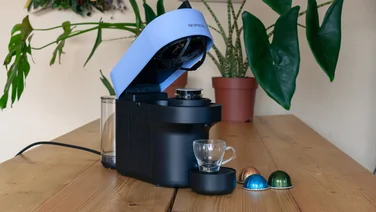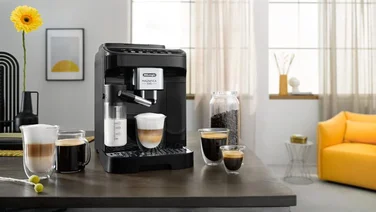To help us provide you with free impartial advice, we may earn a commission if you buy through links on our site. Learn more









- PID temperature control
- Large 58mm portafilter
- Capacious water tank
- Chokes on very finely ground coffee
- Steam wand is weak
A good barista makes brewing espresso look simple, but be in no doubt – it is far from a straightforward process, even with a coffee machine as basic as the ProCook Espresso Coffee Machine.
If you’re willing and able to put in the time and learn the craft, though – and invest another £100 to £200 in a decent coffee grinder – then you’ll find this ProCook model rather capable. It is a very well made and competent manual espresso machine, if a little on the basic side.
What do you get for the money?
While the ProCook Espresso Coffee Machine is as cheap as manual espresso coffee machines get, you do get a surprising amount for your £199. In the box is the machine itself, a pair of 58mm single-wall portafilter baskets (one single shot, one double), a pin for cleaning gunk from the steam wand, plus a (mostly) plastic tamper.
This tamper isn’t the usual afterthought that’s thrown into the box with most machines at around this price, either. It’s a little on the light side, but it looks just like the real thing, providing a metal surface for compressing your coffee and a stubby plastic handle that gives you plenty to grip as you push down.









In fact, the machine as a whole is surprisingly robust and good looking. The chassis is mostly constructed from plastic, but the outer surfaces are made from pressed aluminium and its blue backlit LCD display looks the business. If you like the way Sage’s premium coffee machines look, but can’t justify spending that much, then this ProCook option will be just the ticket.
The machine’s portafilter is built from cast aluminium and so doesn’t have much heft to it, but it slides home with a smooth, tight-feeling thunk and it’s well made with a thick, high-quality plastic handle. As noted above, the whole machine has a heft that belies its low price; even the steam wand feels built to last. If you had asked me how much it cost just from the looks and overall first impression, I’d have said around £400 at least, potentially more.









It doesn’t end at accessories, build and aesthetics, though. The machine is also surprisingly well specified. That portafilter takes standard 58mm baskets, which is the same size as commercial machines, meaning that there are plenty of third-party options to choose from if you want to up your espresso game further down the track.
Its pump runs at up to 15 bar of pressure, and its thermoblock heating system gets up to temperature in double quick time, so you shouldn’t be waiting around to make coffee as you would with a boiler-based machine. Not only that, but it has a PID temperature controller for precision control over the internal heating of the water it pushes through your coffee, which you can adjust to between 90 and 96℃ to suit the beans you’re using. Plus, there’s even a three-way solenoid valve for releasing the pressure in the system after brewing.
In general, the ProCook is as well endowed with features as I’ve seen from a coffee machine costing this little. Indeed, many machines costing far more, have fewer features than this £200 brewer.
What’s it like to use?
Like most good manual espresso machines, the ProCook is very easy to use. To brew coffee, you simply press the power button once to turn it on, wait for it to heat up, which takes less than a minute, then lock in your portafilter and tap the one cup or two cup button on the front panel. After a brief pre-infusion and another few seconds – how long depends on how finely you grind your beans – your drink will appear in your cup, complete with a lovely foamy crema.









It’s also very quiet, never reaching anything louder than a quiet hum while brewing. And steaming and dispensing hot water is straightforward. All you do is press the relevant button, wait for the lights to stop flashing to indicate the thermoblock is ready, then press the button to start the process and once again to stop it.
The large blue-backlit LCD screen is simple and clear, too. It doesn’t serve much practical purpose though, other than to indicate the amount of time that has elapsed per shot and which temperature setting you’ve selected.
I also like how large and easy to remove the water tank is. It has a roomy capacity of 2.2 litres and is simply lifted up and away from the rear so you can carry it over to the sink to fill.
What’s the coffee like?
As usual with espresso, the devil is in the details and here is where ProCook begins to struggle. Despite the fact that the machine’s pump is rated at 15 bar, I found it struggled with finer grinds. With my Baratza Vario W+ coffee grinder set to nearly its finest setting and 18g of Brazilian coffee in the basket (coffee of the month at Crafthouse Coffee), the ProCook chugged away for around 40 seconds, produced around 10ml of coffee and then shut itself down. I was able to rescue this brew by pressing the button again, but the result was watery and bitter.
Still, I did find it relatively easy to make adjustments and dialling in the ProCook isn’t too troublesome. Taking the grind size down a notch or three produced 68g of coffee from 18g of ground beans in 35 seconds – a little on the large side, but again I found this relatively easy to tweak.









Simply hold the double shot button down until your coffee is the right size, let go and the machine will remember the setting for use the next time around. With a temperature of 96℃ selected on the screen, the coffee from the spout registered at 85℃ and up to 70℃ in the cup.
With some work, then, it’s perfectly possible to produce palatable espresso with the ProCook Espresso Coffee Machine. The espresso it produces looks the part and, to a large extent, tastes good, as do milk based drinks. If I’m being honest, I never quite got it to the point where I was fully satisfied – it can’t quite match my Gaggia in that regard – but it isn’t bad at all for the price. And I suspect my dissatisfaction is most likely rooted in my preference for relatively lightly roasted coffee beans, which are harder to extract than medium or dark roasted beans.
ProCook Espresso Coffee Machine review: What could be better?
Being a relatively low budget espresso machine, the ProCook does have some weaknesses. First up, I’m not too keen on the steam wand. It’s just a little underpowered, and I found it tough to produce the sort of micro foam I’m used to on my modified Gaggia Classic. Suffice to say, it’s not the sort of thing you’ll be practising your latte art with.









And despite the fact that it has a 58mm portafilter, don’t make the mistake of assuming it will work with every after-market basket. I tried my 58mm IMS Competizione in the ProCook and found it an extremely tight fit in the group head – you have to give it a real yank to lock the portafilter home. It might loosen up given time, but it’s not something I’d want to do with regularity.
Should you buy the ProCook Espresso Coffee Machine ?
However, these are relatively small gripes and for £200 I find it very hard to find any other serious faults. The ProCook Manual Espresso machine is well equipped, simple to use, quiet, easy to adjust and looks great on your worktop.
Its pump isn’t the strongest, so it’s perhaps not the best for brewing the most exotic, light-roasted beans, but as long as you stick to medium and dark roasts, it’s a cracking little machine for not much cash.






